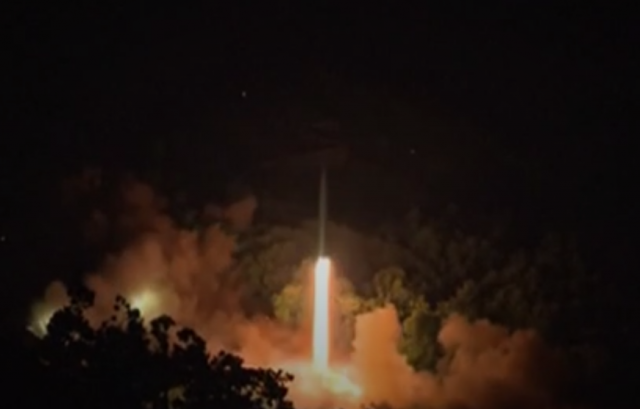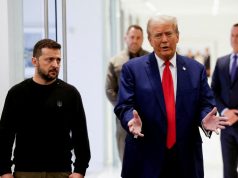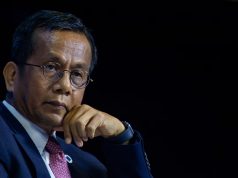WASHINGTON/SEOUL — North Korea is working on plans for a missile strike near the U.S. Pacific territory of Guam, calling President Donald Trump’s warning of “fire and fury” a “load of nonsense” and that only “absolute force can work on him.”
Pyongyang’s state-run KCNA news agency issued an update on its strike plans after Trump’s incendiary comments on Tuesday that threats to the United States from Pyongyang would be met with “fire and fury.”
Trump’s unexpected remarks prompted North Korea to say it was considering plans to fire four intermediate-range missiles to land 30-40 kilometers (18-25 miles) from Guam, home to about 163,000 people and a U.S. military base that includes a submarine squadron, an air base and a Coast Guard group.
The army will complete its plans in mid-August, ready for North Korean leader Kim Jong Un’s order, KCNA said on Wednesday, citing General Kim Rak Gyom, commander of the Strategic Force of the Korean People’s Army.
The news agency said Trump “let out a load of nonsense about ‘fire and fury’,” adding “sound dialogue is not possible with such a guy bereft of reason and only absolute force can work on him.”
On global markets, the strong rhetoric and sharp increase in tensions drove investors out of stocks and other risky assets on Wednesday and into textbook safe havens like gold and Treasuries.
U.S. Defense Secretary Jim Mattis issued a stark warning earlier on Wednesday, telling Pyongyang the United States and its allies would win any arms race or conflict.
“The DPRK should cease any consideration of actions that would lead to the end of its regime and the destruction of its people,” Mattis said in a statement, using the acronym for North Korea’s official name, the Democratic People’s Republic of Korea.
The United States and South Korea remain technically still at war with North Korea after the 1950-53 Korean conflict ended with a truce, not a peace treaty. North Korea regularly threatens to destroy the United States.
Boasts about power
Tension in the region has risen since North Korea carried out two nuclear bomb tests last year and two intercontinental ballistic missile tests in July. Trump has said he will not allow Pyongyang to develop a nuclear weapon capable of hitting the United States.
On Wednesday, Trump followed up his “fire and fury” warning with a boast about U.S. nuclear capabilities.
“My first order as President was to renovate and modernize our nuclear arsenal. It is now far stronger and more powerful than ever before,” Trump tweeted. “Hopefully we will never have to use this power, but there will never be a time that we are not the most powerful nation in the world!”
Trump’s “fire and fury” remarks prompted warnings from U.S. officials and analysts not to engage in rhetorical games with Pyongyang.
U.S. Secretary of State Rex Tillerson, who was in Guam on a previously scheduled visit, played down the rhetoric, saying he did not believe there was an imminent threat from North Korea and “Americans should sleep well at night.”
Trump’s “fire and fury” warning was meant to send a “strong message to North Korea in language that (North Korean leader) Kim Jong Un would understand, because he doesn’t seem to understand diplomatic language,” Tillerson said.
On Wednesday, Trump followed up his “fire and fury” warning with a boast about U.S. nuclear capabilities.
“My first order as President was to renovate and modernize our nuclear arsenal. It is now far stronger and more powerful than ever before,” Trump tweeted. “Hopefully we will never have to use this power, but there will never be a time that we are not the most powerful nation in the world!”
Trump’s “fire and fury” remarks prompted warnings from U.S. officials and analysts not to engage in rhetorical games with Pyongyang.
U.S. Secretary of State Rex Tillerson, who was in Guam on a previously scheduled visit, played down the rhetoric, saying he did not believe there was an imminent threat from North Korea and “Americans should sleep well at night.”
Trump’s “fire and fury” warning was meant to send a “strong message to North Korea in language that (North Korean leader) Kim Jong Un would understand, because he doesn’t seem to understand diplomatic language,” Tillerson said.
Guam threat
Earlier on Wednesday, Guam Governor Eddie Calvo dismissed the threat and said the island was prepared for “any eventuality” with strategically placed defenses. He said he had been in touch with the White House and there was no change in the threat level.
North Korea, pursuing missile and nuclear weapons programs in defiance of U.N. Security Council resolutions, accuses the Washington of devising a “preventive war” and has said any plans to execute this would be met with an “all-out war, wiping out all the strongholds of enemies, including the U.S. mainland.”
Washington has warned it is ready to use force if needed to stop North Korea’s ballistic missile and nuclear programs but that it prefers global diplomatic action, including sanctions. The U.N. Security Council unanimously imposed new sanctions on North Korea on Saturday.
U.S military officials played down the potential for military conflict. Three U.S. officials, speaking on condition of anonymity, said the United States had not moved additional assets into the region after North Korea’s threats against Guam.
“Just because the rhetoric goes up, doesn’t mean our posture changes,” one official said. “The only time our posture goes up is based on facts, not because of what Kim and Trump say to each other,” the official added.
While Trump said the nuclear arsenal was more powerful than ever before, U.S. officials say it takes decades to actually modernize nuclear weapons. Trump signed an executive order in January to initiate a review of the country’s nuclear policy.
‘Complex and sensitive’
A senior administration official who deals with the Korea issue said the “fire and fury” comment, which was Trump’s strongest warning yet for North Korea, was “unplanned and spontaneous.”
“There had not been any discussions about escalating the rhetoric in response to Kim’s statements or about the possible effects of doing that,” the official said.
But White House spokeswoman Sarah Sanders told reporters national security officials had been aware of the tone of Trump’s message before he gave it.
“The words were his own. The tone and strength of the message were discussed beforehand,” Sanders said.
Critics included fellow Republican John McCain, head of the Armed Forces Committee in the U.S. Senate, who said Trump should tread cautiously. “You’ve got to be sure you can do what you say you’re going to do,” McCain said in a radio interview.
Democratic Senator Jack Reed, the top Democrat on the committee, said Trump’s words were counterproductive. “Defusing the North Korea threat will take smart, steady leadership and stronger diplomatic ties with our key allies,” Reed said.
Republican Senator Cory Gardner said the administration needed to lean on China, North Korea’s closest ally, using sanctions. “It’s time to hold China accountable for their refusal to shut off trade with North Korea,” Gardner said.
China, despite its anger at Pyongyang’s missile and nuclear programs, described the situation as “complex and sensitive,” and urged calm and a return to talks.
“China calls on all sides to uphold the main direction of a political resolution to the Korean peninsula nuclear issue, and avoid any words or actions that may intensify the problem and escalate the situation,” the government said in a statement sent to Reuters, repeating its customary stance.










